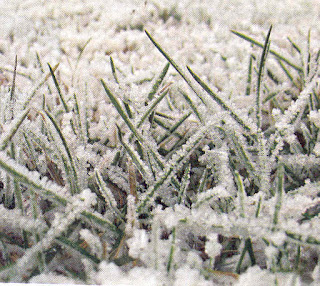Understanding Frost Delays
The following article, Understanding Frost Delays was presented by the Golf Course Superintendents Association of America.
 As we exit the scorching extremes of summer and move into cooler fall temperatures, the desire to hit the golf course intensifies. It also signals a change in golf course management activities that can affect one’s game and the conditions found on the course.
As we exit the scorching extremes of summer and move into cooler fall temperatures, the desire to hit the golf course intensifies. It also signals a change in golf course management activities that can affect one’s game and the conditions found on the course. In many regions of the country, golfers occasionally face frost delays in the mornings, thus pushing back starting tee times. When frost is present golf course superintendents delay play until the frost has melted. This is done to prevent damage that affects the quality of the playing surface and could potentially be very expensive to repair.
Frost is basically frozen dew that has crystallized on the grass, making it hard and brittle. A grass blade is actually 90 percent water, therefore it also freezes. Because of the short mowing height (sometimes as low as 1/8 inch) and fragile nature of the turf, putting greens are most affected by frost. Walking on frost-covered greens causes the plant to break and cell walls to rupture, thereby losing its ability to function normally. When the membrane is broken, much like an egg, it cannot be put back together.
Golfers who ignore frost delays will not see immediate damage. The proof generally comes 48-72 hours later as the plant leaves turn brown and die. The result is a thinning of the putting surface and a weakening of the plant. The greens in turn become more susceptible to disease and weeds. While it may not appear to be much of an issue if a foursome begins play early on frost-covered greens, consider the number of footprints that may occur on any given hole by one person is approximately 60. Multiply that by 18 holes with an average of 200 rounds per day and the result is 216,000 footprints on greens in a day or 6,480,000 in a month.
As golf enthusiasts, superintendents do not like to delay play, but they are more concerned about turf damage and the quality of turf conditions for the golfer. Frost also creates a hardship on a golf facility’s staff as all course preparations are put to a halt until thawing occurs. Golf carts can cause considerable damage, therefore personnel cannot maneuver around the course to mow, change cup positions, collect range balls, etc.
One technique employed to reduce possible frost damage is to raise the cutting height of mowers to create a heartier surface. It may also be possible to reroute play to holes where the frost melts more quickly. But regardless of these methods, the best medicine is for all to understand the hows and whys of the delay and in turn gain a greater appreciation for the golf course. It would also be wise to give the course a phone call before heading out to play to see if tee times have been pushed back due to frost.
For more information regarding golf course maintenance and etiquette, contact your local superintendent or the Golf Course Superintendents Association of America at http://www.gcsaa.org/.



